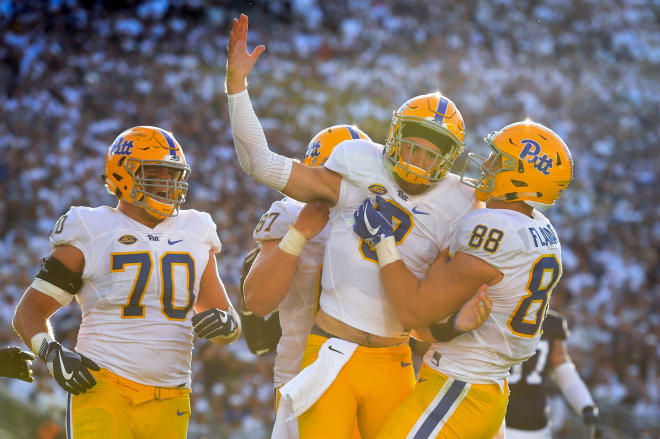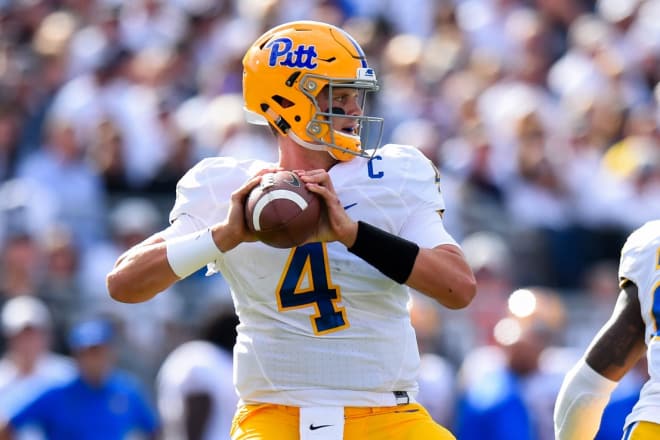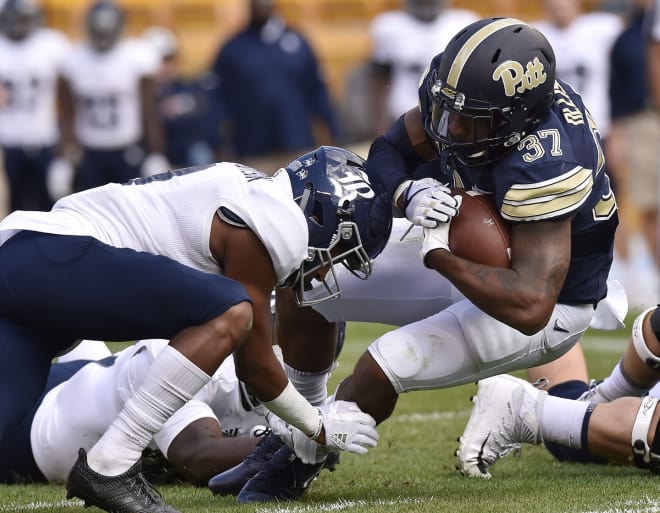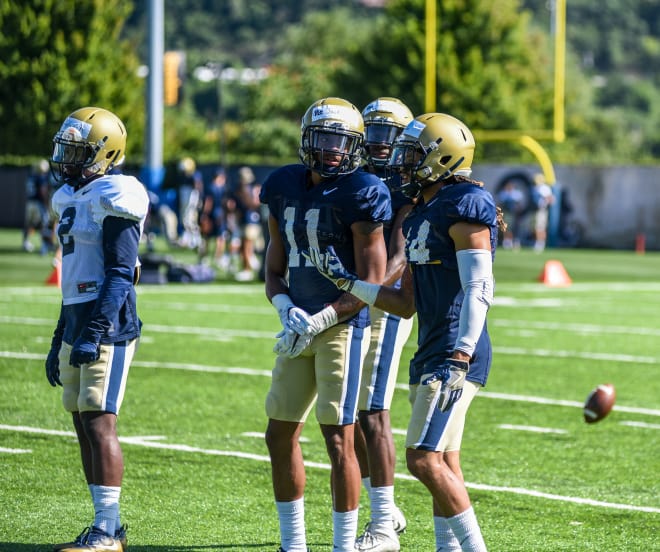The Panther-Lair.com 3-2-1 Column: Syracuse week
MORE HEADLINES - Narduzzi on Ford, Moss, Clark, Syracuse a lot more | Video: Narduzzi's final talk before Syracuse | Behind Enemy Lines: Syracuse | Will Pitt continue to rotate on the OL? | Inside the numbers: A near-perfect day for the passing game | Film breakdown: Where is Pitt's run game?
Welcome to another edition of the Panther-Lair.com 3-2-1 Column, where we look at three things we know, two questions we have and one prediction.

THREE THINGS WE KNOW
This is a huge game
Yes, every game is important and it’s a one-game season and it’s the ACC where every game is important and all of that. But setting aside the motivational clichés, Pitt’s game at Syracuse tomorrow is crucial.
Because while the players and coaches can and will continue to talk about the Coastal Division title and the ACC championship game, we know that the most immediate goal is a bit smaller. Right now, the goal is a bowl, and to get to the postseason, Pitt needs four more wins in the next seven games - an achievement that is no lock.
N.C. State, Virginia, Duke and Virginia Tech all look more formidable than they did in the preseason, and North Carolina and Miami always give Pitt trouble, regardless of whether they are in an up year or a down year. Digging four wins out of that half-dozen is going to take a significantly higher level of play than we saw from the Panthers in their first three games against Power Five competition. So the importance of getting a win this weekend is magnified in light of the increasingly more difficult weeks to follow.
Of course, winning at the Carrier Dome is no gimme either. The last three Pitt-Syracuse games at the Dome, which draws its architecture from that short-lived period in building design when mimicking prisons was the fashion of the day, have been decided by a total of five points. That includes the 2012 game, when Pitt lost to Syracuse 14-13 as part of the Orange’s 8-5 campaign that made Doug Marrone look like an NFL head coach, at least to the ownership of the Buffalo Bills.
That 2012 game was Pitt’s first loss at the Dome since 2004; two years before that, in 2002, the Panthers broke a 20-year losing streak at central New York’s largest hollow block of concrete with a balloon on top.
So there are no guarantees when it comes to Pitt playing Syracuse at the Carrier Dome. But compared the other six opponents on the schedule, the Orange would appear to be the most beatable, and with a slim margin for error in the pursuit of bowl eligibility, the Panthers need to take advantage of any matchup that favors them, even slightly (although they are 3.5-point underdogs as of this writing).

Browne should have a big game
We’re trying really hard not to over-estimate the lasting impact of Max Browne’s 410-yard/4-touchdown display of near-perfection against Rice, but it’s tough. Browne was on point last Saturday in a way he hasn’t been all season - heck, in a way that not many Pitt quarterbacks have been in a long time. That was the first 400-yard game by a Pitt QB since Tom Savage did it at Duke in 2013, and Tino Sunseri had a 400-yard game of his own two years before that.
For all of his shortcomings, one thing Sunseri excelled at doing was playing in the Carrier Dome. In two career starts there, he completed 42-of-57 passes (73.7%) for 600 yards and four touchdowns. Savage and Nate Peterman didn’t have quite as much success - Savage was 28-of-41 for 218 yards, one touchdown and one interception in 2013; Peterman was 19-of-25 for 189 yards in 2015 - but there is precedent for a Pitt quarterback to have success in the Dome.
The question of whether Browne can follow that line lies in close parallel with one of the biggest questions facing the team as it heads into the final seven games: Can Browne carry over his success against Rice into the rest of the season?
Obviously the opponent has to be considered, as Rice is one of the worst FBS teams in the country. But ideally, there were enough “opponent-independent” things Browne did that can be carried over against any opponent - things like making quick decisions and being really sharp in his passes, both in terms of getting the ball out quickly and putting the right touch on the ball. Browne gave his receivers a chance to make plays, and while it always looks better when the receivers actually make those plays, he did a better job of putting the ball out there for them against Rice than he had in the first four games.
Syracuse hasn’t given up a ton in the passing game this season; the Orange rank in the 60’s nationally, allowing 225 yards per game. No opponent has thrown for more than 300 yards against Syracuse in 2017, but then again, those four teams - Central Connecticut State, Middle Tennessee, Central Michigan, LSU and N.C. State - have combined for four total 300-yard games all season (out of 20 combined games played).
Browne might not break the 300-yard mark, but we’re thinking he keeps enough of the rhythm from the Rice game to put together a pretty nice stat line by the time the final whistle blows on Saturday.

Five games seems like an ample sample size for the running backs
With the midpoint of the season quickly approaching - it’s next week, you know, - the running back issue still isn’t resolved.
Things started off well enough. Qadree Ollison topped 90 yards in each of the first two games, and it seemed like Pitt was close to getting its first 100-yard rusher since James Conner went for 115 against Syracuse last year.
Now the streak of consecutive games without a runner hitting the century mark is at six games dating back to last season, quickly approaching the eight-game streak from 2011-12. And the backs on the current team aren’t even getting close. Chawntez Moss had 22 yards against Rice, which was actually an improvement on the Georgia Tech game, when Qadree Ollison led Pitt’s running backs with 11 yards on seven carries.
In the last three games, Moss, Ollison, Darrin Hall and AJ Davis have carried the ball 53 times and gained 108 yards - just barely clearing two yards per carry.
If the backs had a rough game at the start of the season or struggled through two games or even three, it would be dismissible to some degree: everybody hits a rut, a game takes a different course, offensive lines take time to get settled in or whatever it is. But after five games, it’s tough not to draw conclusions about what’s been happening the field and how the players who are getting the opportunities are not doing much of anything with them.
Pitt simply doesn’t have a running game right now. The offensive line shares some blame for that, as do the coaches for some elements of the game plan and play-calling. But the best ingredient in a strong running game is a few good backs, and through five games, it doesn’t look like Pitt has that piece of the puzzle.

TWO QUESTIONS
Are the offensive line tryouts over?
Okay, nobody at Pitt called last week’s constant rotations on the offensive line a “tryout,” but it’s not hard to see it that way. With an inferior opponent coming to Heinz Field in Week Five and big questions still looming up front, it makes sense for the coaches to have used the opportunity to get ample snaps for the guys who are still competing for starting jobs and sort things out for the future based on the film from that game.
The way the coaches rotated sure did feel like it was a scrimmage. Brandon Hodges started at right guard. Then he was replaced by Mike Herndon. Then Hodges. Then Herndon. Then Hodges. Then Herndon. Then Hodges. Then Herndon for the final four drives.
And then there were rotation at center. Jimmy Morrissey played the first three drives before Connor Dintino came out for a possession. Then Morrissey got two drives. Then Dintino got two drives. Then Morrissey got two and Dintino finished it out by playing the final possession.
Oh, and for the final two drives, the coaches also brought Jaryd Jones-Smith off the bench at right tackle, but that was probably less of a tryout rotation than it was a chance to get him some snaps after he moved out of the starting job.
All told, the offensive line combinations changed on every possession against Rice; not once did the coaches use the same lineup on consecutive drives. That’s fine against Rice; Pitt obviously was able to score and pass at will (running…not so much). But now it’s time for ACC games, and it probably goes without saying that the rotation has to stop.
At least, you would hope it will stop. You hope that the coaches find five linemen they like enough to start and play the whole game. That would be the ideal scenario for the offense, and if the rotations continue, it will be more than a little concerning.
Continuity and cohesion are so often referenced as key elements in effective offensive line play (aside from, you know, talent). Can the line really be effective with that much rotation? OL coach John Peterson downplayed the impact the rotations had, but it’s hard to believe. It’s also hard to believe the rotations will continue this week and beyond.

How much have the defensive backs really improved?
Pitt’s secondary is kind of an enigma. On one hand, the players in the back end seem to be better than they were last year, either from personal improvement or personnel upgrades. On the other hand, when, in the context of the Pitt-Oklahoma State game, it actually makes sense to say “Mason Rudolph threw for only 497 yards against Pitt” - well, it’s tough to see much improvement.
The reality of the secondary is somewhere in between. In four out of five games, the defensive backs played pretty well, not allowing a wide receiver to record more than 55 yards. But in that one game against the toughest passing offense Pitt will see this season, the Panthers were gashed by not one, not two, not three but four 100-yard receivers.
Now here comes Syracuse, with Steve Ishmael and his 51 receptions and Ervin Phillips and his 44 catches - both totals surpassing Pitt’s leading receiver from last season. Phillips has caught 28 passes in the last two games; Ishmael has double-digit catches in three of five games, and in the two games when he was held to fewer than 10 receptions, he still topped 100 yards.
Ishmael leads the ACC in receptions and receiving yards. Phillips is No. 2 in receptions and No. 3 in yards. The only thing they’re really not doing is scoring touchdowns: Ishmael and Phillips have two receiving touchdowns each - only one more than Jester Weah and Rafael Araujo-Lopes have combined to catch.
Last year against Pitt, Ishmael had seven catches for 76 yards and Phillips had 107 yards on 11 catches (both were behind Amba Etta-Tawo, who caught 13 passes for 178 yards and five scores). That Pitt secondary was different from this one, though; it was depleted by injury with Avonte Maddox and Jordan Whitehead both out, and starting cornerback Ryan Lewis got hurt as well, so the corners were Dane Jackson and Philllipie Motley. Both players were inexperienced and struggled.
This year, though, Maddox and Whitehead are healthy and Jackson has been one of the bright spots. And the play at field safety has been improving as well, with Damar Hamlin and Bricen Garner showing positive signs as second-year players. So can this unit do better against Syracuse’s receivers than last year’s did? Can these defensive backs challenge and contain Ishmael and Phillips more effectively than LSU and N.C. State did? (Combined totals: Phillips and Ishmael had 22 catches for 216 yards and two touchdowns against LSU and 23 catches for 308 yards and one score against N.C. State.)
This is the second big test of the season for the secondary, and while the performance against Oklahoma State wasn’t all their fault, they’re going to need to have a big day against Syracuse for the team to have a chance. Pitt might be able to get some points in this game, but the Panthers probably aren’t quite ready for a track meet with a Dino Babers offense. The secondary has to make a few plays; Phillips and Ishmael might get some catches and yards, but if the defensive backs can get a couple breakups and a pick or two, they’ll have a chance.

ONE PREDICTION
Pitt will have a 100-yard receiver
Jester Weah’s 137 yards against Rice were the first time a Pitt receiver has gone over the century mark in a game since Weah had 115 yards on three catches in the loss at Miami last November (Scott Orndoff had 128 yards a week later at Clemson, but we’re just talking receivers here).
Historically, though, Pitt’s receivers have done well at the Carrier Dome. Nate Peterman’s numbers weren’t great in the Panthers’ 2015 trip to Syracuse, but Tyler Boyd put up 93 yards on 12 catches. Two years before that, Boyd had 82 yards on 10 catches and Manasseh Garner caught seven for 61 yards and a touchdown. In 2012, Devin Street had 130 yards on 10 catches. And in 2010, Street and Mike Shanahan combined for 146 yards and two touchdowns on seven receptions.
This year’s receivers, with a good dose of speed and quickness, seem like they should be able to take advantage of the fast track at the Dome. A player like Weah should be able to use his speed well, and shifty runners like Quadree Henderson and Maurice Ffrench should be good for a few big plays (last year, those two combined for 180 rushing yards and two touchdowns on six rushing attempts against Syracuse, and that was on the Heinz Field turf in late November).
And of course Rafael Araujo-Lopes and Aaron Mathews will likely continue to do what they’ve been doing for the last few weeks: catch almost everything thrown to them and get first downs at a really high rate.
In the second half of the Rice game, Pat Narduzzi instructed offensive coordinator Shawn Watson to ditch the conservative run-run-pass approach and be aggressive through the air, despite the score being convincingly in Pitt’s favor. If the rushing attack is listless again this week, Narduzzi won’t - or at least shouldn’t - hesitate to make the same call. If Browne gets a little time, there will be plays to be made in the passing game.
And I think that will turn into a triple-digit performance by one of Pitt’s receivers.
